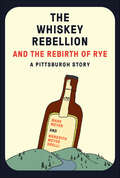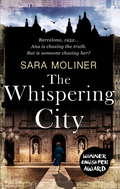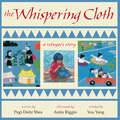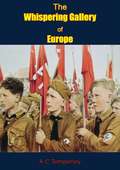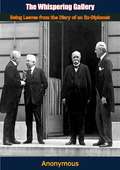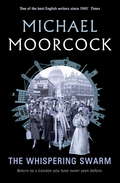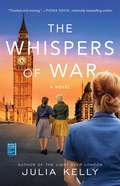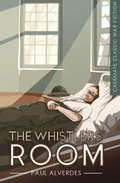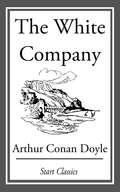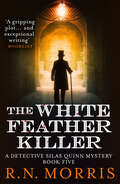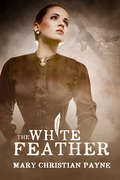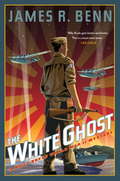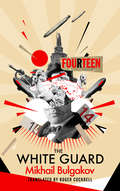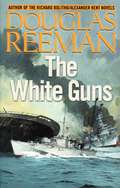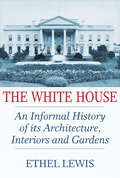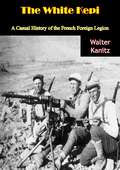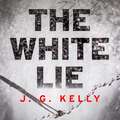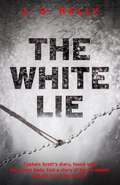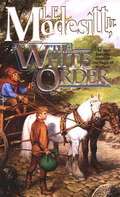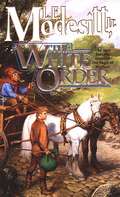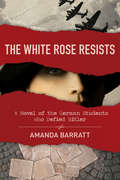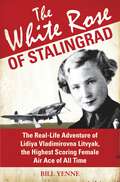- Table View
- List View
The Whiskey Rebellion and the Rebirth of Rye: A Pittsburgh Story
by Mark Meyer Meredith Meyer Grelli&“A mix of elevating spirits and fractious politics&” this history of the whiskey industry in the rust belt &“goes down nice and smooth.&” —John Allison, Pittsburgh Quarterly A short history of rye whiskey&’s founding, floundering, and current flourishing in Pittsburgh. The book takes the reader on a fun tour of the Whiskey Rebellion, the role of Pittsburgh robber barons in developing the rye industry, and the rebirth of craft distillery in the twentieth century. Includes an illustrated guide to making rye whiskey and recipes.
The Whispering City
by Sara MolinerWinner of an English PEN 'PEN Translates!' award.Barcelona, 1952: General Franco's fascist government is at the height of its oppressive powers, casting a black shadow across the city. When wealthy socialite Mariona Sobrerroca is found dead in her mansion in the exclusive Tibidabo district, the police scramble to seize control of the investigation. Ana Martí Noguer, an eager young journalist, is surprised to be assigned this important story, shadowing Inspector Isidro Castro.But Ana soon realises that a bundle of strange letters unearthed at the scene point to a sequence of events dramatically different from the official version. She enlists the help of her cousin Beatriz, a scholar, and what begins as an intriguing puzzle opens up a series of revelations that implicate the regime's most influential figures. The two women have placed themselves in mortal danger. As the conspiracy unfolds, Ana's courage and Beatriz's wits will be their only weapons against the city's corrupt and murderous elite.
The Whispering City
by Sara MolinerWinner of an English PEN 'PEN Translates!' award.Barcelona, 1952: General Franco's fascist government is at the height of its oppressive powers, casting a black shadow across the city. When wealthy socialite Mariona Sobrerroca is found dead in her mansion in the exclusive Tibidabo district, the police scramble to seize control of the investigation. Ana Martí Noguer, an eager young journalist, is surprised to be assigned this important story, shadowing Inspector Isidro Castro.But Ana soon realises that a bundle of strange letters unearthed at the scene point to a sequence of events dramatically different from the official version. She enlists the help of her cousin Beatriz, a scholar, and what begins as an intriguing puzzle opens up a series of revelations that implicate the regime's most influential figures. The two women have placed themselves in mortal danger. As the conspiracy unfolds, Ana's courage and Beatriz's wits will be their only weapons against the city's corrupt and murderous elite.
The Whispering Cloth: A Refugee's Story
by Pegi Deitz SheaMai spends her days at the Widows' Store, listening to the Hmong women as they stitch and talk, stitch and talk. They are making pa'ndau---brightly colored story cloths--which they sell to the traders from Chiang Khan. Mai wishes she, too, could make one of the beautiful pa'ndau, but what story could she tell? This moving and poignant tale depicts life in a refugee camp in Thailand. Mai lives there with her grandmother, who helps her as she struggles to perfect her stitchery. Only by going back into her own brief and tragic past can she find a story to tell--one of hope and faith in the midst of war and confinement. Anita Riggio has rendered lush and sensitive watercolors that frame the story. You Yang, a Hmong immigrant, has stitched the pa'ndau that tell Mai's tale.
The Whispering Gallery of Europe
by A C TemperleyThe Whispering Gallery of Europe, which was first published in 1938, comprised the personal records and opinions of a man who had been close to matters of international moment. Politics were an absorbing interest to the author and he has made this book a very vital record.General A. C. Temperley was one of the chief British representatives at Geneva during the ten years of discussions on disarmament and during this period he was military adviser to four Foreign Secretaries. In a foreword, The Right Honourable Anthony Eden says, “The position you held as chief military adviser gave you exceptional opportunities for contacts with other delegates and you made splendid use of them. Your patience, experience and impartiality were everywhere recognised until you became something in the nature of an arbiter at Geneva.”The failure of the League of Nations to fulfil the expectations so hopefully awaited can be readily understood after reading The Whispering Gallery of Europe. A. C. Temperley tells of lack of leadership and academic discussion which could not look beyond the immediate problem to take a long view.
The Whispering Gallery: Being Leaves from the Diary of an Ex-Diplomat
by AnonymousThe Whispering Gallery: Being Leaves from the Diary of an Ex-Diplomat, which first appeared anonymously in 1926, takes the form of a portrait gallery, consisting of brief biographical sketches of public figures. Three chapters treat single individuals: Lord Northcliffe (‘The Napoleon of Fleet Street’), Lord Leverhulme (‘The Soap King’), and Edward VII (‘The Peacemaker’). The other chapters mostly group several subjects by profession: the ‘Warriors’ include Lord Kitchener, Lord Roberts, John French, and Marshal Joffre; the chapter on ‘Empire-Builders’ juxtaposes Cecil Rhodes with Joseph Chamberlain; the ‘Three Caesars’ are the Kaiser, the Tsar and Franz Josef; the ‘Two Despots’ are Mussolini and Lenin; the ‘Scribblers’ include H. G. Wells, Bernard Shaw, Thomas Hardy, Henry James, Rudyard Kipling and Mark Twain.“To move in high social or diplomatic circles is to live in a whispering-gallery. No secret can be breathed without the startling reverberation of rumor from an unexpected quarter. The secrets I breathe afresh in these pages the reader may have heard in the echo of hearsay, an echo which distorts the words that were actually spoken and alters the very character of the speakers themselves.”
The Whispering Swarm
by Michael MoorcockWith his first full novel in almost ten years (not counting his Doctor Who book), Michael Moorcock - the most influential figure in modern fantasy and science fiction - returns to the city of his birth. London has always been a central character in Moorcock's work, from the high-literary fiction of MOTHER LONDON to the roof gardens of Jerry Cornelius.Now return to London just after the war, a city desperately trying to get back on its feet. And one young boy, Michael Moorcock, who is about to discover a world of magic and wonder. Between his first tentative approaches to adulthood - a job on Fleet Street, the first stirrings of his interest in writing - and a chance encounter with a mysterious Carmelite Friar, we see a version of Moorcock's life that is simultaneously a biography and a story. Mixing elements of his real life with his adventures in a parallel London peopled with highwaywomen, musketeers and magicians, this is Moorcock at his dazzling, mercurial best.
The Whispers of War (Bestselling World War II Fiction)
by Julia KellyFrom the author of The Last Garden in England and The Light Over London comes a &“gripping tale by a writer at the top of her game&” (Fiona Davis, author of The Chelsea Girls) following three friends who struggle to remain loyal as one of them is threatened with internment by the British government at the start of World War II.In August of 1939, as Britain watches the headlines in fear of another devastating war with Germany, three childhood companions must choose between friendship and country. Erstwhile socialite Nora is determined to find her place in the Home Office&’s Air Raid Precautions Department, matchmaker Hazel tries to mask two closely guarded secrets with irrepressible optimism, and German expat Marie worries that she and her family might face imprisonment in an internment camp if war is declared. When Germany invades Poland and tensions on the home front rise, Marie is labeled an enemy alien, and the three friends find themselves fighting together to keep her free at any cost. Featuring Julia Kelly&’s signature &“intricate, tender, and convincing&” (Publishers Weekly) prose, The Whispers of War is a moving and unforgettable tale of the power of friendship and womanhood in the midst of conflict.
The Whistlers' Room: A Novel (Casemate Classic War Fiction #10)
by Paul AlverdesAn &“extremely atmospheric and poignant&” novel of wounds that never heal and lives forever scarred by World War I (Books Monthly). They&’re called Whistlers—residents of a German hospital who have all been wounded in the throat, and whose every breath is punctuated with a high-pitched whistle. One young soldier, Pointner, has no hope for recovery. His only solace comes from the British sniper&’s cap he keeps as a trophy. Fellow casualty Kollin clings to the belief that he will be whole again. When an unlikely comrade joins them in the ward—the Englishman Harry, similarly injured but separated by allegiance—they find themselves bound, beyond the countries and crowns that have forgotten them, not only by their wounds but also by their common humanity.
The White Company
by Sir Arthur Conan DoyleThis spirited account of the exploits of a crew of Saxon archers during the Hundred Years War features cameo appearances by historical figures such as Edward III and the Black Prince. Flavorful and realistic in its depictions of medieval life, the novel combines the excitement of a rugged adventure with the romance of chivalry.
The White Donkey: Terminal Lance
by Maximilian UriarteA graphic novel of war and its aftermath. A powerful, compulsively page-turning, vivid, and moving tribute to the experience of war and PTSD, The White Donkey tells the story of Abe, a young Marine recruit who experiences the ugly, pedestrian, and often meaningless side of military service in rural Iraq. He enlists in hopes of finding that missing something in his life but comes to find out that it's not quite what he expected. Abe gets more than he bargained for when his journey takes him to the middle east in war-torn Iraq. This is a story about a Marine, written and illustrated by a Marine, and is the first graphic novel about the war in Iraq from a veteran. The White Donkey explores the experience of being a Marine, as well as the challenges that veterans face upon their return home, and its raw power will leave you in awe. <P><P> <i>Advisory: Bookshare has learned that this book offers only partial accessibility. We have kept it in the collection because it is useful for some of our members. Benetech is actively working on projects to improve accessibility issues such as these.</i>
The White Feather Killer (Detective Silas Quinn Mysteries)
by R. N. MorrisA Scotland Yard detective probes a gruesome murder with a single feather as his only clue in this gripping historical mystery set in World War I London. London, 1914. The declaration of war with Germany has made the capital a dark, uncertain place. As the pressure on young men to enlist grows, Pastor Cardew holds a rally at his church. It ends in humiliation for Felix Simpkins when he receives a dreaded white feather—the ultimate sign of cowardice. Meanwhile, DI Silas Quinn returns to New Scotland Yard after his recent sick leave to find the Special Crimes Department has been closed and his team absorbed into CID. But when a body is discovered in Wormwood Scrubs the day after Cardew&’s rally, a white feather placed in its mouth, Quinn finds himself unable to take a back seat in the investigation. Was the murderer really a foreign spy . . . or someone closer to home? The final installment of the Silas Quinn mysteries, perfect for fans of Abir Mukherjee, S. G. MacLean and S. J. Parris.Praise for The White Feather Killer&“Features a flawed hero, disturbing undertones, a gripping plot, realistic period ambience, taut suspense, and exceptional writing.&” —Booklist &“Morris builds tension slowly but effectively in this character-driven fifth franchise installment.&” —Kirkus Reviews&“Superior. . . . Morris nicely evokes the tense atmosphere of London in August 1914. A complex lead and an intricate puzzle elevate this entry.&” —Publishers Weekly
The White Feather: A Novel Of Forbidden Love In World War I England
by Mary Christian PayneEven war cannot destroy true love . . . A conflict of the heart drives the first historical romance in the captivating Claybourne Trilogy. The White Feather is a poignant, romantic, and sometimes tragic novel set on the battlefields of World War I France and in a small village named Claybourne-on-Coln. This engaging novel presents the reader with unforgettable characters, courageous and cowardly, generous and self-serving. Mary Christian Payne takes you to a quaint English village where Lord Christopher Claybourne lives with his new American wife, Eleanor, and his mother, the Dowager Lady Cynthia, in his opulent family estate. At the other end of the village lives Lily Barton in a charming cottage with her widowed mother, Elisabeth. Their worlds meet at the beginning of World War I. This first novel in the Claybourne Trilogy takes the reader on an adventurous journey, fraught with peril, both at home and abroad. A story of selfishness, devotion and loyalty, culminating in a perplexing mystery, The White Feather will leave you wanting more of the Claybourne family. This novel is a stand-alone book to be enjoyed by itself or followed up with books two and three in the trilogy, The White Butterfly and White Cliffs of Dover.
The White Ghost
by James R. BennIn the Pacific during WWII, Billy Boyle must discover if skipper, and future president, Jack Kennedy is a cold-blooded killer.1943: In the midst of the brutal, hard-fought Solomon Islands campaign between the Allies and the Japanese forces, Lieutenant Billy Boyle receives an odd assignment: he's sent by the powerful Kennedy family to investigate a murder in which PT skipper (and future president) Jack Kennedy has been implicated. The victim is a native coastwatcher, an allied intelligence operative, whom Kennedy discovered on the island of Tulagi with his head bashed in. That's Kennedy's story, anyhow.Kennedy was recovering in the Navy hospital on the island after the sinking of his PT-109 motor torpedo boat. The military hasn't decided yet whether to make him a hero for surviving the attack, or have him court-martialed for losing the boat, and the last thing the Kennedy clan wants is a murder charge hanging over his head. Billy knows firsthand that he shouldn't trust Jack: the man is a charmer, a womanizer, and, when it suits his needs, a liar. But would he kill someone in cold blood? And if so, why? The first murder is followed by two more, and to find the killer, Billy must sort through a tangled, shifting web of motives and identities, even as combat rages all around him.
The White Guard: Belaya Gvardiya
by Mikhail BulgakovA Kyiv family is caught up in the Ukrainian War of Independence in this novel by the author of The Master and Margarita, drawing from his own life. Reds, Whites, German troops, and Ukrainian nationalists battle for control of the city of Kyiv as the war becomes more tumultuous in Mikhail Bulgakov&’s debut novel, The White Guard. Drawing heavily from the author&’s own experiences in Ukraine during the period of the Russian Civil War—he witnessed ten changes of government himself—The White Guard is told from alternating points of view and takes an unusual angle in the conflict between Russian Whites (with whom the Turbin family identify) and Ukrainian nationalists. It elegantly portrays the chaos of a civil war in which there is no good or evil, only loyalty to one&’s friends, family, and convictions. First appearing in partial form in a Soviet-era literary journal, the story was turned into a play under the title The Days of the Turbins—a long-running hit that Stalin himself attended twenty times—yet was not published widely until decades after Bulgakov&’s death.
The White Guns
by Douglas ReemanIt's Spring 1945 and the war has ended in Europe, but the hate and devastation linger on. Lieutenant Vere Marriott of the Royal Navy, and the men of Motor Gunboat 801 are moored in Kiel harbor, witness to the disintegration of the mighty German navy. Where once they fought just to stay alive, Marriott and his men must now learn how to accept peace.
The White House: An Informal History of its Architecture, Interiors and Gardens
by Ethel LewisThe White House, first published in 1937, is a fascinating look at the building—and rebuilding —of the presidential White House as well as vivid descriptions and insights into the lives of the ‘first families’ who lived there (from John Adams up to Franklin Roosevelt), and of the changes each new President brought to the building, its interior and grounds, and to the surrounding city. Following its construction at the turn of the 19th century, the White House was for a long period uncompleted, neglected, and trampled by hordes of careless visitors, as well as home to successive presidents and their families attempting to conduct the nation’s business, host numerous parties and provide lodging for visiting foreign dignitaries. Renovations were on-going, and each First Lady would change rooms to reflect her own or the prevailing interior style popular at the time. Additions to the cramped quarters were planned and usually rejected. Concurrently, Washington D.C. was changing from a disease-ridden swamp with unpaved, muddy streets, into a planned city with wide paved boulevards on the Parisian model. Included are 16 pages of illustrations depicting changes in the exterior and interior of the White House since its construction.
The White Kepi: A Casual History of the French Foreign Legion
by Walter KanitzHeroic figures galloping across the loose sands of the Sahara, their flowing white kepis a symbol of the highest romance and adventure...or murderers and human derelicts, rejected by society and hunted by the police, seeking escape from prison in the ranks of the Légion Étrangère? Neither picture—so commonly held by the general public—is even partially accurate, writes Walter Kanitz.During World War II, Walter Kanitz fought with the Foreign Legion in Africa. He has done a vast amount of research and reading about the Legion, and has made every possible effort to check his facts. His book represents the first comprehensive and objective history of the French Foreign Legion since its inception in 1831 by the royal decree of Louis Philippe.For the better part of its history, the Foreign Legion, remote, fascinating, somewhat sinister, has been shrouded in mystery. It has been called everything from “Desert Carrion” to the “Legion of Beggars.” It was often said that “dogs bark when the Legion passes.” Yet, in battle, the Légionnaires are famed for a courage and heroism that knows no fear of death. They are considered by most professional soldiers to be, as a unit, the best fighting force in the world.When a new recruit applies for enlistment, he is made to wait 24 hours to reconsider his decision. The ranks are made up of men of all nationalities—Germans, Poles, Czechs, Slavs, Spaniards, Americans. It is the only army in existence today made up of mercenaries who have voluntarily signed to serve five years for the government of France. The discipline is harsh and the pay meager. The call to battle has taken Legion units from Mexico to Norway, from China to Morocco. Outside of battle, life consists of infinite boredom broken only by alcohol and an occasional woman. And yet, says ex-Legionnaire Kanitz, “Qu’importe, quand la Légion passe, que les chiens viennent aboyer après d’elle! Vive la Légion!”
The White Lie: The gripping and heart-breaking historical thriller based on a true story
by J.G. KellyThe White Lie is an up-market historical crime thriller based on the legend of Captain Scott.THE LEGEND1913.Captain Scott and his four companions reach the South Pole to find their Norwegian rival Roald Amundsen has won the race. Defeated, they set out on the 850-mile journey to their ship. Apsley Cherry-Garrard, the explorer sent out to meet them at One Ton depot, peering South through thick spectacles, sees only an infinity of white, and turns back. A year later Scott's pitched tent is found, just ten miles from the depot, and the bodies within speak of hunger, the unbearable strain of hauling the sledge, and the brutal winter cold. They lie in a tomb of ice. Cherry is left forever tormented by thoughts of what might have been.THE TRUTH1969. Ten years after Cherry's death, Falcon Grey - who as an orphan of the Blitz was brought up at the explorer's country estate - receives a bequest: a small red notebook that was found in Scott's tent. It is a diary: and it states that they were not victims of the cold, or hunger, but murder, in the coldest of blood. Suspects range from envious foreign powers - such as the Kaiser's Germany - to revolutionaries and even Scott's own men. Vital clues lie in the tent, so Falcon goes South to the ice to see it for himself, but someone is desperate to conceal the truth and will kill to keep the secrets under the ice.(P)2023 Hodder & Stoughton Limited
The White Lie: The gripping and heart-breaking historical thriller based on a true story
by J.G. Kelly'Kelly is that rare combination, a brilliant storyteller, a sure-footed adventurer into the past and a really marvellous writer. With its new take on one of the most compelling episodes in our nation's narrative, The White Lie brings history to life without disturbing its delicate fabric' CHRISTOBEL KENTTHE LEGEND1913. Captain Scott and his four companions reach the South Pole to find their Norwegian rival Roald Amundsen has won the race. Defeated, they set out on the 850-mile journey to their ship. Apsley Cherry-Garrard, the explorer sent out to meet them at One Ton depot, peering South through thick spectacles, sees only an infinity of white, and turns back. A year later Scott's pitched tent is found, just ten miles from the depot, and the bodies within speak of hunger, the unbearable strain of hauling the sledge, and the brutal winter cold. They lie in a tomb of ice. Cherry is left forever tormented by thoughts of what might have been.THE TRUTH1969. Ten years after Cherry's death, Falcon Grey - who as an orphan of the Blitz was brought up at the explorer's country estate - receives a bequest: a small red notebook that was found in Scott's tent. It is a diary: and it states that they were not victims of the cold, or hunger, but murder, in the coldest of blood. Suspects range from envious foreign powers - such as the Kaiser's Germany - to revolutionaries and even Scott's own men. Vital clues lie in the tent, so Falcon goes South to the ice to see it for himself, but someone is desperate to conceal the truth and will kill to keep the secrets under the ice.'Polar aficionados will enjoy this. It suggests alternative endings to legendary stories, casting fresh light on characters we think we know pretty well. An imaginative and compelling recasting, and a fine polar thriller to boot' SARA WHEELER
The White Lie: The gripping and heart-breaking historical thriller based on a true story
by J.G. Kelly'Kelly is that rare combination, a brilliant storyteller, a sure-footed adventurer into the past and a really marvellous writer. With its new take on one of the most compelling episodes in our nation's narrative, The White Lie brings history to life without disturbing its delicate fabric' CHRISTOBEL KENTTHE LEGEND1913. Captain Scott and his four companions reach the South Pole to find their Norwegian rival Roald Amundsen has won the race. Defeated, they set out on the 850-mile journey to their ship. Apsley Cherry-Garrard, the explorer sent out to meet them at One Ton depot, peering South through thick spectacles, sees only an infinity of white, and turns back. A year later Scott's pitched tent is found, just ten miles from the depot, and the bodies within speak of hunger, the unbearable strain of hauling the sledge, and the brutal winter cold. They lie in a tomb of ice. Cherry is left forever tormented by thoughts of what might have been.THE TRUTH1969. Ten years after Cherry's death, Falcon Grey - who as an orphan of the Blitz was brought up at the explorer's country estate - receives a bequest: a small red notebook that was found in Scott's tent. It is a diary: and it states that they were not victims of the cold, or hunger, but murder, in the coldest of blood. Suspects range from envious foreign powers - such as the Kaiser's Germany - to revolutionaries and even Scott's own men. Vital clues lie in the tent, so Falcon goes South to the ice to see it for himself, but someone is desperate to conceal the truth and will kill to keep the secrets under the ice.'Polar aficionados will enjoy this. It suggests alternative endings to legendary stories, casting fresh light on characters we think we know pretty well. An imaginative and compelling recasting, and a fine polar thriller to boot' SARA WHEELER
The White Order: 24 Copy Floor Display (Saga of Recluce #8)
by L. E. Modesitt Jr.<P>L.E. Modesitt, Jr.'s The White Order continues his bestselling fantasy series the Saga of Recluce, which is one the most popular in contemporary epic fantasy. <P>Powerful white mages killed Cerryl's father to protect their control of the world's magic. <P>Raised by his aunt and uncle, Cerryl learns that he has inherited his father's magic abilities. <P> His abilities do not protect him, however. <P>When Cerryl witnesses a white mage destroy a renegade magician, he must send to the city of Fairhaven for his own safety and to find his destiny.
The White Order: 24 Copy Floor Display (Saga of Recluce #8)
by L. ModesittL.E. Modesitt, Jr.'s The White Order continues his bestselling fantasy series the Saga of Recluce, which is one the most popular in contemporary epic fantasy.Powerful white mages killed Cerryl's father to protect their control of the world's magic.Raised by his aunt and uncle, Cerryl learns that he has inherited his father's magic abilities. His abilities do not protect him, however. When Cerryl witnesses a white mage destroy a renegade magician, he must sent to the city of Fairhaven for his own safety and to find his destiny.“An intriguing fantasy in a fascinating world.”—Robert Jordan, New York Times bestselling author of The Wheel of Time® seriesSaga of Recluce#1 The Magic of Recluce / #2 The Towers of Sunset / #3 The Magic Engineer / #4 The Order War / #5 The Death of Chaos / #6 Fall of Angels / #7 The Chaos Balance / #8 The White Order / #9 Colors of Chaos / #10 Magi’i of Cyador / #11 Scion of Cyador / #12 Wellspring of Chaos / #13 Ordermaster / #14 Natural Order Mage / #15 Mage-Guard of Hamor / #16 Arms-Commander / #17 Cyador’s Heirs / #18 Heritage of Cyador /#19 The Mongrel Mage / #20 Outcasts of Order / #21 The Mage-Fire War (forthcoming)Story Collection: Recluce TalesOther Series by L.E. Modesitt, Jr.The Imager PortfolioThe Corean ChroniclesThe Spellsong CycleThe Ghost BooksThe Ecolitan MatterAt the Publisher's request, this title is being sold without Digital Rights Management Software (DRM) applied.
The White Rose Resists: A Novel of the German Students Who Defied Hitler
by Amanda BarrattInspired by the incredible true story of a group of ordinary men and women who dared to stand against evilThe ideal of a new Germany swept up Sophie Scholl in a maelstrom of patriotic fervor--that is, until she realized the truth behind Hitler's machinations for the fatherland. Now she and other students in Munich, the cradle of the Nazi government, have banded together to form a group to fight for the truth: the White Rose. Risking everything to print and distribute leaflets calling for Germans to rise up against the evil permeating their country, the White Rose treads a knife's edge of discovery by the Gestapo.Annalise Brandt came to the University of Munich to study art, not get involved with conspiracy. The daughter of an SS officer, she's been brought up to believe in the Führer's divinely appointed leadership. But the more she comes to know Sophie and her friends, the more she questions the Nazi propaganda.Soon Annalise joins their double life--students by day, resisters by night. And as the stakes increase, they're all forced to confront the deadly consequences meted out to any who dare to oppose the Reich.A gripping testament to courage, The White Rose Resists illuminates the sacrifice and conviction of an unlikely group of revolutionaries who refused to remain silent-no matter the cost.
The White Rose of Stalingrad
by Bill YenneOf all the major air forces that were engaged in the war, only the Red Air Force had units comprised specifically of women. Initially the Red Air Force maintained an all-male policy among its combat pilots. However, as the apparently invincible German juggernaut sliced through Soviet defenses, the Red Air Force began to rethink its ban on women. By October 1941, authorization was forthcoming for three ground attack regiments of women pilots. Among these women, Lidiya Vladimirovna "Lilya" Litvyak soon emerged as a rising star. She shot down five German aircraft over the Stalingrad Front, and thus become history's first female ace. She scored 12 documented victories over German aircraft between September 1942 and July 1943. She also had many victories shared with other pilots, bringing her possible total to around 20. The fact that she was a 21-year-old woman ace was not lost on the hero-hungry Soviet media, and soon this colourful character, whom the Germans dubbed "The White Rose of Stalingrad," became both folk heroine and martyr.
